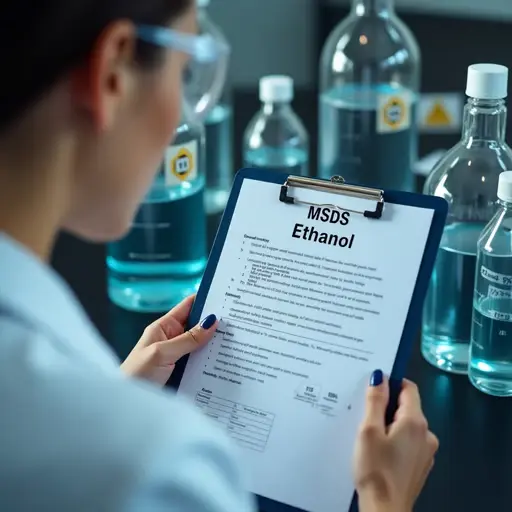Introduction
Ever wondered why a 70% ethanol solution is more flammable than a 90% ethanol solution, despite having less alcohol? Or why some ethanol MSDS sheets seem vague about long-term storage risks? If you handle ethanol—whether in labs, manufacturing, or disinfectant production—this guide will help you decode ethanol safety data sheets (SDS/MSDS) like a pro.
We’ll cover:
✔ How to read and interpret an ethanol MSDS (beyond just skimming hazards).
Critical OSHA and GHS compliance updates (avoid costly fines).
✔ Free, verified ethanol MSDS PDF downloads (no shady sources).
Myths even professionals believe (like “ethanol SDS never expires”).
What’s Missing in Most Ethanol MSDS Sheets?

Most ethanol solution SDS documents list raw data—flash points, LD50 values, NFPA ratings—but don’t explain what they mean for real-world use. Here’s what competitors skip:
A. Decoding NFPA Diamonds
- Health (Blue): Ethanol scores 1 (slight irritation) for 70% solutions but 2 (temporary damage) for 95%+.
- Flammability (Red): 3 for all concentrations—but water content affects evaporation and fire risk.
- Instability (Yellow): 0 (stable) unless mixed with oxidizers like hydrogen peroxide.
B. Why pH Levels Do Matter (Even for Ethanol)
Pure ethanol has a neutral pH (~7), but denatured ethanol solutions often contain acidic/basic additives. Check Section 9 (Physical Properties) for pH—if it’s below 6 or above 8, corrosion-resistant storage is needed.
C. The “Fine Print” in Section 16 (Other Information)
Most users ignore this, but it lists:
- MSDS revision dates (expired? You’re non-compliant).
- Disposal codes (D001 for flammable liquids).
Ethanol Solution Hazards: Beyond the Basics
Hazard Comparison Table
Concentration Flash Point Key Health Risks Storage Requirements
70% Ethanol 17°C (63°F) Skin dryness, eye irritation Ventilated area, <30°C
95% Ethanol 13°C (55°F) Severe eye damage, CNS depression Fireproof cabinet, no sunlight
Pro Tip:
- 70% ethanol spills evaporate more slowly (higher water content = lingering slip hazards).
- 95%+ ethanol ignites more easily but burns out faster.
OSHA & Global Compliance: What Competitors Ignore
A. US vs. EU Regulations
Requirement OSHA (US)REACH (EU)
Labeling GHS pictograms and CLP symbols
Exposure Limits 1,000 ppm (8-hr TWA) 500 ppm (STEL)
Real-World Penalty: A Texas lab was fined $15,625 in 2023 for outdated ethanol MSDS sheets.
B. GHS Updates (2024)
- New pictograms for ethanol inhalation risks (Section 2).
- Mandatory QR codes on SDS for digital access (by 2025).
Free MSDS Downloads + How to Spot Fakes
Trusted Sources for Ethanol MSDS PDFs
- Sigma-Aldrich (Search for “ethanol solution”).
- Fisher Scientific (Filter by concentration).
- PubChem (NIH-backed data).
Red Flags in Fake MSDS:
❌ No supplier contact info.
❌ Missing GHS symbols.
“Generic” ethanol hazards (no concentration-specific data).
Ethanol Myths Debunked
Myth 1: “Ethanol MSDS Never Expire”
- Truth: OSHA requires updates every 3–5 years or when new hazards are identified.
Myth 2: “All Ethanol Grades Have Identical Hazards”
- Truth: 70% ethanol is less flammable but more irritating to skin than 95% ethanol (see Section 11 of your SDS).
FAQs
Q: Can I use a 10-year-old ethanol MSDS?
A: No. OSHA mandates updates every 3–5 years. Fines start at $1,000 per violation.
Q: Is an ethanol solution MSDS required for hand sanitizers?
A: Yes, if ethanol exceeds 3% concentration (FDA rule for commercial producers).
Q: Does 70% ethanol need special disposal?
A: Only if contaminated (e.g., with heavy metals). Otherwise, small amounts can evaporate in fume hoods.
Final Checklist: Is Your Ethanol MSDS Compliant?
✅ GHS/OSHA-aligned? (Check revision date).
✅ Concentration-specific hazards? (Not “generic ethanol”).
✅ First-aid measures for ingestion/inhalation?
✅ Supplier contact info visible?